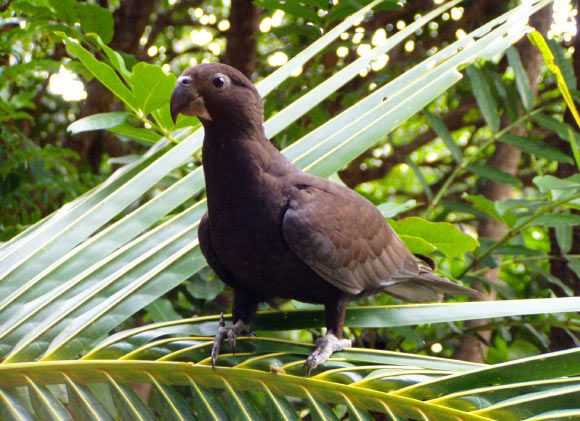A team of researchers from the United Kingdom has uncovered the first evidence of tool use by greater vasa parrots (Coracopsis vasa), unusual birs found throughout Madagascar and the Comoros.

A greater vasa parrot (Coracopsis vasa) in Madagascar. Image credit: Adventure Expedition Madagaskar / CC BY-SA 3.0.
“The use of tools by non-human animals remains an exceedingly rare phenomenon,” said Megan Lambert of the University of York, a team member and the lead author on a paper published online this week in the journal Biology Letters.
“We report the first evidence, to our knowledge, of tool use by greater vasa parrots (Coracopsis vasa).”
Studying 10 captive vasa parrots, Ms Lambert and her colleagues observed the birds adopt a novel tool-using technique to acquire calcium from seashells and also the active sharing of tools among themselves.
The birds used small pebbles or date pits to grind calcium powder from the shells or to break off small pieces of shell to ingest.
“Several members of a captive population spontaneously adopted a novel tool-using technique by using pebbles and date pits either (i) to scrape on the inner surface of seashells, subsequently licking the resulting calcium powder from the tool, or (ii) as a wedge to break off smaller pieces of the shell for ingestion,” the scientists wrote in the paper.
Observing and filming the birds over an eight month period, the team documented their interactions with cockle shells on the floor of their aviary.
“Shells are a known source of calcium for birds,” the scientists explained.
Five birds were documented using tools, placing either pebbles or date pits inside shells to grind against the shell, or using them as a wedge to break apart the seashell. Interest in the shells was greatest from March to mid-April, just before the breeding season – this may be due to calcium supplementation being critical for egg-laying.
The team was therefore initially surprised to find that it was the males, not the females who showed the greatest interest in shells. However, observation of the parrots’ breeding behavior showed that males often engaged in regurgitative feeding of females before copulating with them, thus potentially passing on the calcium benefits.
“Our observations of tool transfer are particularly intriguing as it is rarely observed in other species and outside of mother-offspring dyads,” Ms Lambert and co-authors added.
“Transfers occurred exclusively from males to females. This pattern is similar to that reported for chimpanzees, where females primarily obtained tools from males by means of tolerated theft, and in some cases, females were in oestrus and transfer took place a short time before or after copulation.”
“The greater vasa parrot joins the small minority of extant species documented as tool users,” the researchers said.
“While other species are known to ingest seashells as calcium supplements, this bird’s method for doing so appears to be entirely unique.”
“Although archaeological records document grinding tool use by humans up to 30,000 years ago, to the best of our knowledge, this is the first report of a non-human using a tool for grinding,” they said.
_____
Megan L. Lambert et al. A novel form of spontaneous tool use displayed by several captive greater vasa parrots (Coracopsis vasa). Biology Letters, published online December 16, 2015; doi: 10.1098/rsbl.2015.0861







